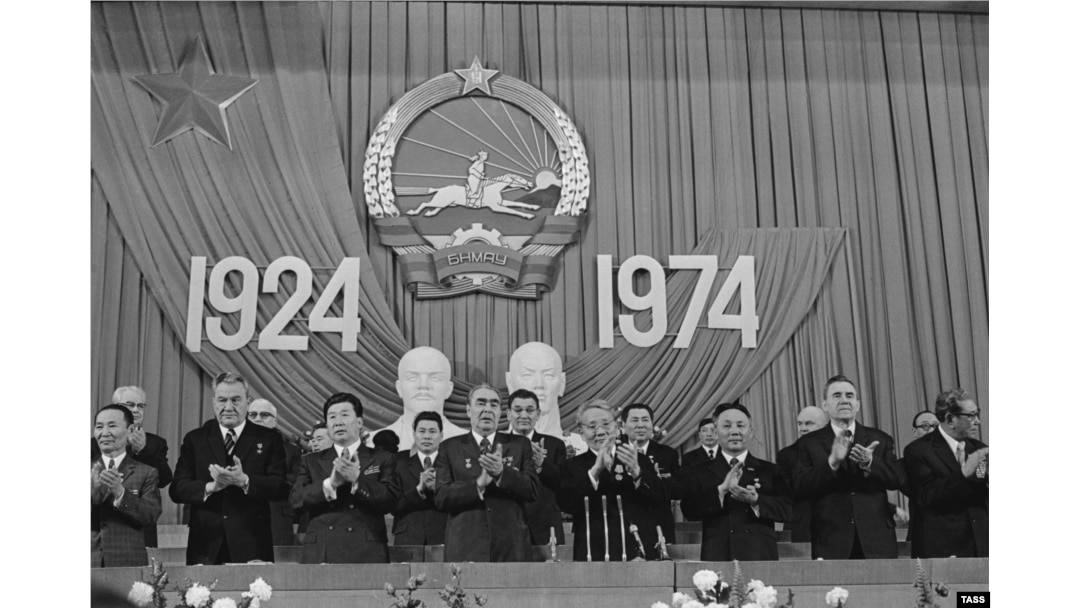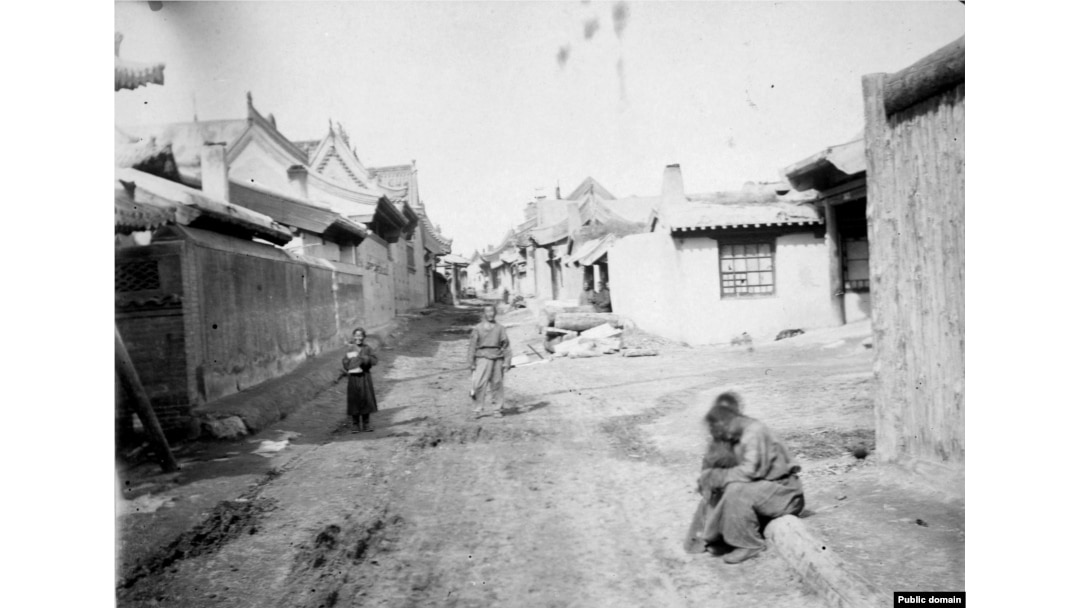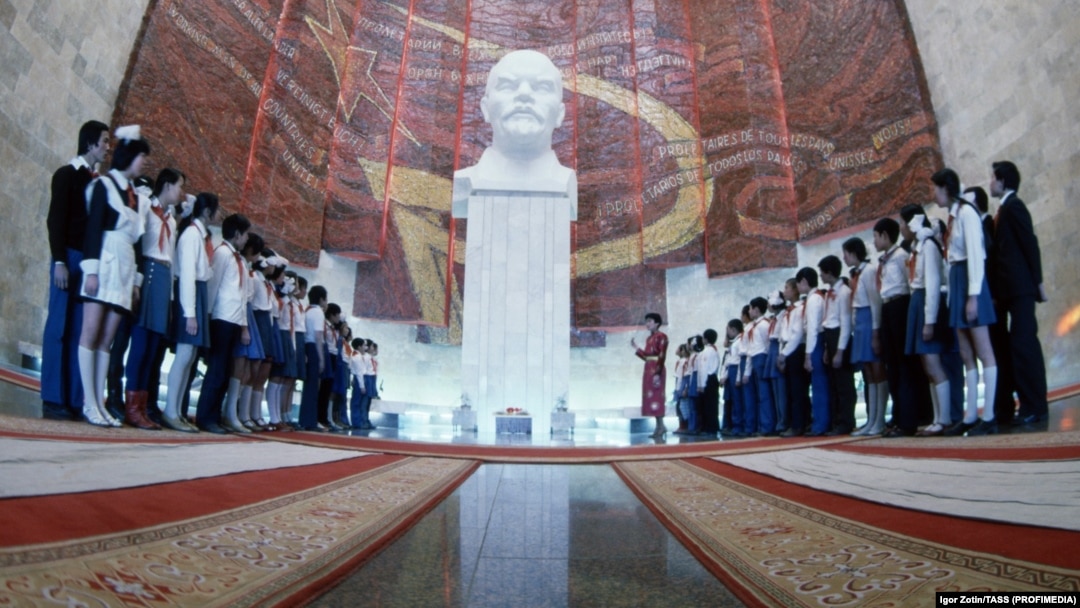Mongolia declared itself a “people’s republic” 100 years ago on November 26, 1924. But despite the name of its capital city remaining Ulan Bator (Red Hero), the country’s Soviet-linked past has been widely described as “forgotten.”

Soviet leader Leonid Brezhnev (center left) marks 50 years of the Mongolian People's Republic alongside Mongolia's communist leader Yumjaagiin Tsedenbal (center right) in Ulan Bator on November 1, 1974.
Jonathan Addleton, who served as the U.S. ambassador to Mongolia from 2009 to 2012, told RFE/RL that the country's Soviet-linked past is often overlooked because “it is the figure of Genghis Khan who looms largest in how Mongolia is viewed by the rest of the world. Nothing can ever overshadow or replace that image as the central feature of Mongolian history."

A street scene in Altanbulag, a Mongolian trading town on the border with Russia, in the late 1800s.
Additionally, Addleton says, due to its remoteness and the fact Mongolia never joined the Warsaw Pact -- the Soviet Union’s equivalent of NATO -- the country “never entered into the popular imagination in terms of what it meant to be a ‘Soviet satellite.’”
The Chinese governor of Altanbulag surrounded by his retinue in the late 1800s.
In 1924, the sparsely populated territory of today’s Mongolia had endured years as a sparring ground between China and forces from both sides of Russia’s Civil War. But the region remained de jure a part of China.
Mongolian soldiers photographed in the 1930s
Such was the uncertainty faced by Mongolia's largely nomadic population in 1924 that one young official poured cold water on the communist government’s grandiose “people’s republic” declaration by asking: "But what is a republic? Surely this is unknown in the provinces."
He called on delegates to explain to rural Mongolians "the aim and meaning of the new form of government."
A nomadic herder and his daughter on Mongolia’s plains in March 1936
One of the Kremlin’s early fact-finding missions to Mongolia reported back to Soviet leader Josef Stalin that the Chinese-claimed territory would be a useful “buffer along the southern borders of our country,” which could ensure Soviet and Chinese troops would not come face-to-face.
Women praying at a monastery in Mongolia in 1930
Mongolia was soon economically and politically dependent on the U.S.S.R. and mirroring Moscow's radical policies.
“You must develop socialism in a very short time, and for this purpose apply the experiences of the Soviet Union,” one Kremlin envoy instructed the Mongolian government.
A young Mongolian shepherd with his flock in the 1930s
In 1930, Ulan Bator reported “we are now confiscating the property of the feudal classes.”
As nomadic herdsmen were forced into communal farms and had their cattle seized by the state, some fled the country, while others rose up.
Buddhist stupas in Mongolia in 1936
In the early 1930s, some 30,000 people are estimated to have fled Mongolia and spontaneous rebellions broke out in some regions of the country.
“Fight to the death against the witches and demons of this ‘people’s government!’” was the rallying cry of one religiously inspired rebel group.
Khorloogiin Choibalsan
In 1937, Mongolia's Defense Minister Gelegdorjiin Demid was invited to Moscow and died en route from "food poisoning."
Then, in 1939, Mongolia’s popular prime minister, Anandyn Amar, was arrested and sent to Moscow, where he was eventually executed. The deaths opened the door to Khorloogiin Choibalsan, a favorite of Stalin, to seize power in Mongolia.
A Mongolian archer wearing Soviet medals
Under Choibalsan, the terror of Stalin’s great purges echoed through the halls of power in Ulan Bator. Choibalsan worked directly with the Soviet NKVD secret police to round up and execute “unreliable” government officials, before the state moved on to religious leaders.
The total number of victims of Mongolia’s Great Repression remains unknown, but from 1937 to 1939 some 17,000 lamas were executed and more than 700 monasteries were demolished.
A military parade in Ulan Bator in 1946
Throughout World War II, Mongolia was a vital source of aid to the Soviet military and, in 1945, China was pressured into giving up its claims on Mongolia by a victorious Soviet Union. A referendum on Mongolia's official independence from China resulted in what was claimed to have been a 100 percent vote in favor of the proposal.
Soldiers march during the 1946 parade in Ulan Bator.
Stalin personally showed interest in Mongolia, repeatedly leaning on its government to destroy religion in the country once and for all.
“You must deal firmly with the lamas,” he told Ulan Bator. “You must not forget that only those who are strong will be recognized.”
Soviet-made cars parked near yurts outside Ulan Bator in 1961.
As elsewhere in the Soviet sphere of influence, repressions in Mongolia became less severe after Stalin’s death in 1953, and the Kremlin's ruthless war on religious faith became more of a bureaucratic tussle.
Worshippers at the Gandan Monastery in Ulan Bator in 1962. Only elderly Buddhists were allowed to pray at the monastery at the time, with younger Mongolians permitted only as “casual viewers,” according to the original caption of this photo.
According to Addleton, Moscow was seen as the least bad option for Mongolians from its two powerful neighbors.
A street scene in Ulan Bator in 1969
“Realistically, the [Soviet] Russian connection was important for Mongolia in terms of both reasserting its independence and guaranteeing its sovereignty vis-à-vis China,” the ex-ambassador says.
A statue of Josef Stalin in front of Ulan Bator’s National Library in 1971
By the late 1980s, the Soviet Union had some 50,000 troops and 1,800 tanks, along with 320 planes and helicopters, stationed at several bases across the country.
Mongolians wait in lines to buy meat in Ulan Bator in 1988.
As democracy movements began gathering strength elsewhere on the fringes of the Soviet Union, Mongolians in the 1980s also started to push for freedom against a surprisingly lenient government.
A protester waves the flag of Mongolia's Democratic Party in Ulan Bator in July 1990.
Jambyn Batmonkh, the last leader of communist Mongolia, recalled resisting officials that were seeking a crackdown on protests against one-party rule, saying, “There is no need to utilize the police or involve the military.”
The protesters, he said, “are our children.”
In March 1990, Mongolia's Politburo was replaced and Batmonkh announced his resignation, paving the way for free elections.
People gather around a statue of Stalin that was pulled down and removed from in front of the National Library in early 1990.
Addleton says Mongolians he has spoken to about their country's era as a Soviet satellite “have expressed a wide range of views about the Soviet Union."
A Mongolian man on the steps of a monument in Ulan Bator commemorating the country's support of the Soviet Union during World War II. The photo was taken in independent Mongolia in 1996.
"While some have expressed bitterness toward the Stalinist-era purges during the 1930s and the execution of members of the Buddhist clergy," Addleton says, "others look back on the post-World War II era with a degree of appreciation and even nostalgia.”


